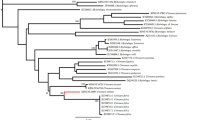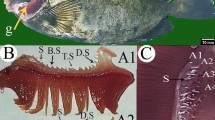Summary
Autoradiographs of the subcommissural organ (SCO), the Reissner's fibre (RF), the ependymal horder and other areas of the brain, as well as non-neural organs of the body of the carp, Cyprinus carpio L., were prepared 4 hours to 76 days after the injection of 35S-cystine.
-
1.
Four hours after the injection of 35S-cystine labeled secretory material was found in the cisterns of the SCO-cells. The 35S concentration in the SCO and in the RF is generally higher than in all other areas of the brain investigated. As to the quantities of 35S incorporated the tissues investigated range as follows: Islets of Langerhans>RF>plexus>neurosecretory cells>ependymal border>cerebellum>commissura posterior.
-
2.
The daily growth rate of RF is 0.5–2.3% of total length of the cerebrospinal canal from SCO to the filum terminale. The substances making up the RF may pass the third and fourth ventricles and the central canal of the spinal cord within 42–221 (average 64) days. The quantity of secretion released by the SCO of the carp into the third ventricle amounts to 0.3×10−4 mg—4.0×10−4mg daily (rate of secretion). That amounts to 0.5–5% of the total weight of the organ.
-
3.
The entire RF from the SCO to the terminal ampoule of the central canal weighs 1.7x 10−2mg. This is up to 260 mg of RF material per 100 g of cerebrospinal fluid. During its growth RF releases no labeled substances. Labeled material gets into RF from the surrounding cerebrospinal fluid by diffusion.
-
4.
35S activity in the ependymal border of the filum terminale and the terminal ampoule, as well as the cerebrospinal fluid and the (non-labeled) RF of these areas is higher than in ependymal border, the cerebrospinal fluid, and the (non-labeled) RF of other spinal cord areas.
Zusammenfassung
Vom Subkommissuralorgan (SKO) und dem Reissnerschen Faden (RF), dem Ependym und anderen Bereichen des ZNS sowie Organen der Leibeshöhle des Karpfens (Cyprinus carpio L.) wurden 4 Std bis 76 Tage nach 35S-Cystinapplikation und histologischer Aufbereitung Autoradiogramme hergestellt und untersucht.
-
1.
Markiertes Material in den Sekretzisternen der Zellen des SKO liegt 4 Std nach der Injektion von 35S-Cystin vor. Die 35S-Cystinkonzentration im SKO und im RF ist im allgemeinen größer als die Anreicherung von aktivem Material in den übrigen untersuchten Hirnbereichen. Die Gewebe bzw. Organe können nach der Menge des eingebauten 35S zu folgender Reihe geordnet werden: Langerhanssche Inseln>Plexus>neurosekretorische Zellen>Ependym> Cerebellum>Commissura posterior.
-
2.
Das tägliche Wachstum (Wachstumsrate) des RF beträgt 0,5–2,3% der Länge des Hirn-Rückenmarkkanales vom SKO bis zur Ampulla terminalis. Die Fadensubstanz passiert das Hirnhohlraumsystem in etwa 42–221 (durchschnittlich 64) Tagen. Die vom SKO des Karpfens abgegebene Sekretmenge (Sekretionsrate) beträgt 0,3·10−4 bis 4,0·10−4 mg/Tag, d.h. etwa 0,5–5% des Eigengewichtes des Organes.
-
3.
Die Gesamtmasse des RF vom SKO bis zur Ampulla terminalis beträgt bis zu etwa 1,7·10−2 mg. Dieser Wert entspricht einer Menge von etwa 260 mg RF-Substanz auf 100g Liquor. Der RF gibt während seines Wachstums durch das Hirnkammersystem keine markierten Substanzen ab. Durch Diffusion gelangt Aktivität aus dem umgebenden Liquor in den RF.
-
4.
Die 35S-Aktivität in den Ependymzellen des Filum terminale und der Endampulle, im Liquor und im nicht markierten RF dieser Bereiche ist größer als in den Ependymzellen, im Liquor und im nicht markierten RF anderer Rückenmarksabschnitte.
Similar content being viewed by others
Literatur
Berson, S. A.: Immunoassay of plasma insulin. Ciba Foundation Colloquia on Endocrinology, vol. 14, Immunoassay of hormones. London: J. & A. Churchill, Ltd. 1962.
Dawson, H.: The cerebrospinal fluid. In: Ergehn. Physiol. 52, 21–73 (1963).
Ermisch, A.: Autoradiographische Untersuchungen am SKO und dem Reissnerschen Faden. Internat. Symposium über Circumventriculäre Organe und Liquor, Reinhardsbrunn, Mai 1968 (im Druck).
Fährmann, W.: Durchschneidung des Reissnerschen Fadens im Rückenmark von Salmo irideus. Naturwissenschaften 49, 113–114 (1962).
-: Der Reissnersche Faden nach Durchschneidung des Rückenmarks bei Salmo irideus (Gibbons). Z. Zellforsch. 58, 820–836 (1963).
Hofer, H.: Neuere Ergebnisse zur Kenntnis des Subkommissuralorgans, des Reissnerschen Fadens und der Massa caudalis. Verh. der Dtsch. Zool. Ges. München 1963. Zool. Anz., Suppl. 27, 430–440 (1964).
Mautner, W.: Studien an der Epiphysis cerebri und am Subcommissuralorgan der Frösche. Z. Zellforsch. 67, 234–270 (1965).
Naumann, W.: Histochemische Untersuchungen am Subkommissuralorgan und am Reissnerschen Faden von Lampetra planeri (Block). Z. Zellforsch. 87, 571–591 (1968).
Oksche, A.: Histologische, histochemische und experimentelle Studien am Subkommissuralorgan von Anuren. (Mit Hinweisen auf den Epiphysenkomplex). Z. Zellforsch. 57, 240–326 (1962).
Olsson, R.: An experimental breakage of Reissner's fibre in the central canal of the pike (Esox lucius). Z. Zellforsch. 46, 12–17 (1957).
- The subcommissural organ. Stockholm: Ivar Haeggströms Boktryckeri-AB 1958.
Palm, U.: Vergleichend histologische und histochemische Untersuchungen am Reissnerschen Faden der Fische, Amphibien und Reptilien. Diplomarbeit 1967 (unveröffentlicht).
Sargent, P. E.: Reissner's fibre in the Canalis centralis of Vertebrates. Anat. Anz. 17, 33–44 (1900).
Stanka, P.: Über den Sekretionsvorgang im Subkommissuralorgan eines Knochenfisches (Pristella riddlei, Meek). Z. Zellforsch. 77, 404–415 (1967).
-: Morphologische Studie über den Reissnerschen Faden bei niederen Wirbeltieren. Z. Zellforsch. 85, 67–77 (1968).
Steffen, W.: Der Karpfen. Die Neue Brehm-Bücherei, Ziemsen-Verlag H. 203 (1958).
Sterba, G.: Zur cerebrospinalen Neurokrinie der Wirbeltiere. Zool. Anz., Suppl. 29, 393–440 (1966).
-, A. Ermisch, K. Freyer, and G. Hartmann: Incorporation of sulphur-35 into the subcommissural organ and Reissner's fibre. Nature (Lond.) 216, 504 (1967).
-, H. Müller u. W. Naumann: Fluoreszenz- und elektronenmikroskopische Untersuchungen über die Bildung des Reissnerschen Fadens bei Lampetra planeri (Bloch). Z. Zellforsch. 76, 355–376 (1967).
-, u. W. Naumann: Elektronenmikroskopische Untersuchungen über den Reissnerschen Faden und die Ependymzellen im Rückenmark von Lampetra planeri (Bloch). Z. Zellforsch. 72, 516–524 (1966).
-, u. G. Wolf: Zur Löslichkeit des Reissnerschen Fadens. Biol. Rdsch. 5, H. 6 (1967).
Törk, I.: Autoradiographic examination on different secretory cells producing Gomoripositive material in the central nervous system. Abstracts of Papers for the Fourth Conference of European Comparative Endocrinologists, Carlsbad, August 1967, p. 73–74.
Weindl, A.: Verhalten der circumventriculären Organe des Kaninchens nach intravenöser Trypanblau-Zufuhr. Naturwissenschaften 54, 342 (1967).
Wislocki, G. B., and E. H. Leduc: The cytology and histochemistry of the subcommissural organ and Reissners fiber in rodents. J. comp. Neurol. 97, 515–543 (1952).
Wolf, G.: Über die physikalischen und biochemischen Eigenschaften des Reissnerschen Fadens. Int. Symposium über circumventriculäre Organe und Liquor, Reinhardsbrunn, Mai 1968 (im Druck).
Author information
Authors and Affiliations
Rights and permissions
About this article
Cite this article
Ermisch, A., Sterba, G., Hartmann, G. et al. Autoradiographische Untersuchungen über das Wachstum des Reissnerschen Fadens von Cyprinus carpio (L.). Zeitschrift für Zellforschung 91, 220–235 (1968). https://doi.org/10.1007/BF00364312
Received:
Issue Date:
DOI: https://doi.org/10.1007/BF00364312




